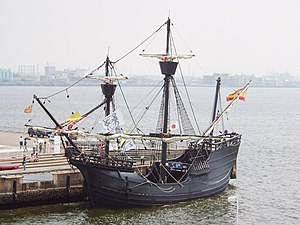
Back سفينة فيكتوريا Arabic Nau Victoria Catalan Victoria (barko) CEB Victoria (loď) Czech Victoria (Schiff, 1519) German Victoria (ŝipo) Esperanto Victoria (nao) Spanish Victoria (itsasontzia) Basque ویکتوریا (کشتی) Persian Victoria (bateau) French

| |
| History | |
|---|---|
| Crown of Spain | |
| Name | Victoria |
| Namesake | Santa Maria de la Victoria |
| Owner | Crown of Spain |
| Acquired | 1518 |
| Renamed | 1519 |
| Fate | Disappeared en route to Seville from the Antilles, 1570 [1] |
| Notes | First ship to circumnavigate the globe. |
| General characteristics | |
| Class and type | Carrack |
| Tonnage | 85 tons |
| Length | 18 to 21 m (59 to 69 ft) |
| Complement | 55 |
Victoria or Nao Victoria (Spanish for "Victory") was a carrack famed as the first ship to successfully circumnavigate the world.[2] Victoria was part of the Spanish expedition to the Moluccas (now Indonesia's Maluku Islands) commanded by the explorer Ferdinand Magellan.
The carrack (Spanish: nao) was built at a Basque shipyard in Ondarroa. Along with the four other ships, she was given to Magellan by King Charles I of Spain (later Emperor Charles V of the Holy Roman Empire). Victoria was an 85-tonel ship[a] with an initial crew of about 42. The expedition's flagship and Magellan's own command was the carrack Trinidad. The other ships were the carrack San Antonio, the carrack Concepción, and the caravel[5] Santiago.
The expedition began from Seville on 10 August 1519 with five ships and entered the ocean at Sanlúcar de Barrameda in Spain on September 20. However, only two of the ships reached their goal in the Moluccas. Thereafter, Victoria was the only ship to complete the return voyage, crossing uncharted waters of the Indian Ocean under Juan Sebastián de Elcano's command to sail around the world. She returned to Sanlúcar on 6 September 1522.[6]
Victoria was later repaired, bought by a merchant shipper and sailed for almost another fifty years before being lost with all hands on a trip from the Antilles to Seville in about 1570.[1]
- ^ a b Bergreen, Laurence (2003). "XV – After Magellan". Over the Edge of the World. New York: HarperCollins. p. 413. ISBN 0-06-621173-5.
Little Victoria, the first ship to complete a circumnavigation, had her own curious epilogue. No one thought to preserve the battered vessel as a testament of Magellan's great achievement. Instead, she was repaired, sold to a merchant for 106,274 maravedis, and returned to service, a workhorse of the Spanish conquest of the Americas. As late as 1570, she was still plying the Atlantic. En route to Seville from the Antilles, she disappeared without a trace; all hands on board were lost. It is assumed that she encountered a mid-Atlantic storm that led to her sinking, her wordless epitaph written on the restless waves.
- ^ "Victoria ship". Archived from the original on 2022-10-03. Retrieved 2022-10-03.
- ^ Joyner 1992, p. 93.
- ^ a b Walls y Merino (1899), Annex 3, p. 174.
- ^ Bergreen, Laurence (2004). "Over the Edge of the World Summary by Michael McGoodwin". Archived from the original on 2015-07-03. Retrieved 2015-07-27.
- ^ Cite error: The named reference
princetonwas invoked but never defined (see the help page).
Cite error: There are <ref group=lower-alpha> tags or {{efn}} templates on this page, but the references will not show without a {{reflist|group=lower-alpha}} template or {{notelist}} template (see the help page).